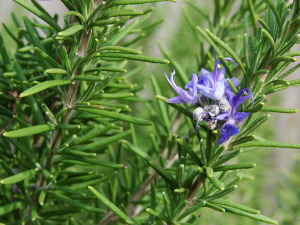Depending on where you live rosemary can be just another annual herb in the garden or a magnificent perennial shrub or hedge plant in your yard. Either way, rosemary is a great foodscaping plant. The characteristic scent and flavor is great cooked with fish, meats and vegetables. You can harvest whole stems and use them as barbeque skewers on the grill. I particularly love rosemary roasted potatoes. This shrubby plant has attractive blue-green leaves and beautiful white, pink or blue flowers. There’s even a creeping version.
Rosemary is hardy to USDA zone 7, and perhaps zone 6 with protection. You can plant rosemary in a vegetable or herb garden along with other culinary herbs, but that’s boring. Try growing rosemary as an annual or perennial flower in a sunny flower border. The leaves and pastel colored flowers provide a nice contrast to other more brightly colored flowers. In warm climates grow rosemary as a hedge to define garden beds. Some varieties grow almost 6 feet tall, but can be trimmed to keep in shape. Grow dwarf varieties in window boxes or containers on a deck or patio.
Attractive Varieties
‘Tuscan Blue’ is a large, upright growing variety with blue flowers. ‘Majorca Pink’ is a pink flowered version. ‘Nancy Howard’ is a bushy white flowered variety. ‘Arp’ is a cold hardy rosemary surviving winter temperatures to -5F. ‘Prostrate’ is a creeping variety good for rock gardens, containers and to cascade over walls.
Good Companions
Plant rosemary in warm areas in the perennial flower garden with other flowers that need similar growing conditions such as salvia and gayfeather. Plant rosemary in an annual flower garden to highlight brightly colored flowers such as celosia and coreopsis. If using rosemary frequently for cooking, place it towards the front or near the walkway for easy access. Plant prostrate varieties in containers with taller annuals, such as heliotrope.
Planting
You can start rosemary from seed, but it’s slow growing. It’s best to select transplants from your local garden center in spring. Rosemary, like thyme and oregano, is a Mediterranean herb that needs full sun, well-drained soil and not much fertility to grow well. Depending on the variety, space plants 1 to 4 feet apart.
Growing
Given sun, warmth and minimal watering, rosemary grows easily in the yard. Fertilize plants in spring with an organic plant food. In areas where it is a perennial, trim the branches in spring to shape the plant and remove any broken or diseased stems as needed. Rosemary has few pests. To overwinter rosemary in colder climates, grow your plants in containers and move them indoors in fall. Indoors, place rosemary in sunny window or under grow lights in a cool mudroom or indoor porch with good air circulation. Keep the soil moist, but not wet.
Harvesting
Harvest stems of rosemary as needed about one month after planting. Cut stems to shape and prune the plant at the same time. Remove the leaves from the stems for cooking or drying.
Excerpted from the book, Foodscaping, (CSP, 2015)



